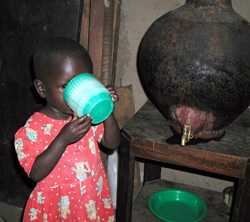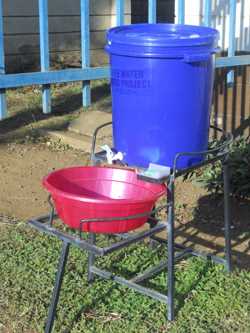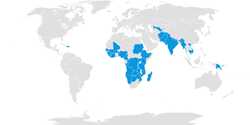The Safe Water System: Stories from the Field
Delivering Health by the Drop
“We can do that”… Families own their health by safeguarding their water
In the world today, close to 1 billion people still drink water collected directly from streams, lakes and shallow, hand-dug wells, while hundreds of millions more drink contaminated water from unsafe municipal systems or borehole wells.
In recent years, decentralized solutions for water treatment at the point of collection or use, combined with education to improve water handling, storage, and hygiene practices, provide many of the health benefits of piped, treated water at far less cost and in far less time.
The Safe Water System (SWS) developed by CDC gives families tools to clean their own drinking water, even when the source is contaminated. This prevention strategy enables individuals to disinfect water by using locally-made, affordable dilute bleach solution; store the safe water in vessels designed to prevent recontamination; and improve hygiene habits through behavior change. This approach, which started in 1998, has reached over 30 countries.

A young girl drinks safe water from a SWS storage vessel in her home.
The inspiration for offering simple solutions directly to households came, not surprisingly, from a mother. The connection to CDC took place in Peru in 1991 when assistance was requested and a team deployed during one of the largest cholera epidemics in Latin America. Many waterborne diseases are capable of causing explosive and highly fatal epidemics. This is particularly true in the absence of early detection and intervention. The textbook example is cholera.
One of the original investigators recounts an auspicious meeting with a “Club de Madres”, or Mothers Club. In the course of working with this important community group, the team was asked by one of the mothers if they feared contracting cholera. Upon demonstrating their simple method of treating their own drinking water by adding iodine tablets, her emboldened response, “we can do that”, served as motivation for the future direction of CDC’s research. The goal: to empower individuals, especially mothers, to safely treat and store water in their homes.
The Safe Water System, demonstrated in dozens of field trails, has been estimated to cut deaths from diarrheal diseases in half for children under five. Innovators from industry, academia, government, and non-governmental organizations have become part of a movement to save millions of lives while boosting local economies.
Since the start of the SWS program, a volume of products sufficient to treat 120 billion liters of water (as of 2012) has been sold. Its applicability is continually being evaluated for wider distribution, including a study by the Bill & Melinda Gates Foundation examining household water treatment and its link to child health and development in Bangladesh and Kenya.
Christian Health Association of Kenya Collaborates with CDC in Safe Water Program
Safe water stations in health care and at home
Limited access to safe water in Nyanza and Western Provinces, Kenya is a major problem. Diarrhea rates in these regions are among the highest in Kenya. An inexpensive safe water system, which includes treatment of water with chlorine solution, safe water storage, and improved hand hygiene, can reduce the risk of diarrhea from 25–85%. Many rural health facilities lack supplies and equipment for treating and safely storing water and for hand washing, making it difficult for healthcare workers to wash their hands between patients, safely administer oral medications, and teach their patients about safe water and hand hygiene in the home.

Handwashing station with plastic bucket containing a tap, metal stand, basin for catching water and soap.
In 2011, the Christian Health Association of Kenya (CHAK) partnered with the Safe Water and AIDS Project (SWAP) in Kisumu, Kenya, the U.S. Centers for Disease Control and Prevention (CDC), and the United Nations Children’s Fund (UNICEF) to address this problem by installing handwashing and drinking water stations and providing training on hygiene and water treatment to healthcare workers in 180 health facilities in western Kenya. The water stations consist of plastic containers with lids and taps, a metal stand, a basin for catching water, a starter supply of locally-produced dilute bleach (called WaterGuard) for on-site water treatment, and soap for handwashing. During training, healthcare workers are encouraged to use these water stations as a platform to teach patients about proper handwashing and safe water treatment and storage in the home. The water stations are portable, which facilitates patient teaching in the health facility and community.
An important component of the Kenya project is an evaluation of impact. In February 2011, CHAK, CDC, and SWAP initiated the program by conducting a baseline survey in a random sample of 40 rural health facilities operated by CHAK and the Kenyan Ministry of Health that included a health facility assessment, healthcare worker interviews, and a household survey of 566 clients. Following baseline data collection, water stations were installed in 180 health facilities and healthcare workers were trained. The evaluation team will return to these health facilities and households to perform a follow-up survey using similar instruments.
The baseline evaluation showed that 83% of health facilities obtained their water from potentially unsafe sources (e.g., rain water, boreholes, surface water) and that treatment of the water with chlorine would help make it safe to drink. Survey respondents from 78% of facilities reported treating their stored drinking water; WaterGuard was the most commonly mentioned water treatment method (87%). Seven (18%) facilities lacked any type of hand washing station. At the remaining 33 facilities, healthcare workers were using water stored in buckets, jerry cans, and jugs to wash hands. Soap was observed in 81% of facilities.
Of 566 clients interviewed in their homes, 347 (61%) reported relying on unimproved drinking water sources. Most, (97%) households lacked any hand washing station and only 30% of women interviewed could demonstrate proper hand washing technique. Although 71% of survey respondents reported treating their water, only 4% had residual chlorine, an indicator of water treatment, in their stored water.
The results of the baseline evaluation demonstrated a clear need for safe hand washing and drinking water stations in many health facilities in rural western Kenya and improved handwashing and water treatment practices and supplies in clients’ homes. A future evaluation will provide a detailed look at program impact.
Life-saving collaborations: USAID and CDC
Where collaboration is our legacy
In global health work, it is important to find legacies that stand the test of time and scrutiny. The collaboration between CDC and the United States Agency for International Development (USAID) to address critical global health issues is one that provides both agencies the opportunity to build such a legacy. In our joint work on water, for example, we have grown from partners to collaborators on promotion of safe drinking water through household water treatment to over two dozen countries in the past decade.
One of the “untold stories” started in 2001, when USAID resources enabled CDC to study a never-before-tested theory of whether people who are HIV positive would benefit from access to household water treatment and safe storage products and hygiene education (now known as “bundling”). Resources from USAID made it possible.
Collaboration allowed CDC to collect conclusive evidence that providing a locally-produced dilute chlorine bleach solution, a closed, lidded water storage container with a spigot, and hygiene education would reduce by nearly two-thirds the frequency and severity of disabling episodes of diarrheal diseases in persons living with HIV/AIDS. Today, the return on this joint-agency investment has changed the way that HIV care is provided through programs funded by the President’s Emergency Plan for AIDS Relief (PEPFAR) and other sources. Conclusive evidence arrived at jointly, and disseminated separately, yet consistently, within each agency and to our external stakeholders has translated into successful projects all over the world. Efforts to establish the evidence-base for other “bundled approaches” have continued and through these efforts, we continue to make a difference together: In Malawi, for example, safe water and hygiene kits (improved water storage containers, water treatment solution, soap, oral rehydration solution or ORS, and maternal education) are integrated with antenatal care in rural clinics focused on preventing mother to child transmission (PMTCT) of HIV/AIDS was recently evaluated.
- Key findings reveal:
- Almost all (99%) mothers in the program and their spouses were tested for HIV.
- Couple disclosure of HIV status was 98%.
- 90% of women delivered their babies in a health facility.
- 72% of women had 4 or more antenatal visits.
- A dramatic rise in household water treatment among participants, increasing from 0% at baseline to 69% one year later; and mothers who could demonstrate proper handwashing increased from 21% to 65%.
- This project was initiated in 2007 with USAID funding, which supported the field work and evaluation by CDC. This is just one of many snapshots of success.
- Consistent, yet separate messages key to success: At the heart of our collaboration on water is our ability to work separately, but consistently. Countries, companies, and our international partner organizations such as WHO, UNICEF and others have benefited from science-based, life-saving products and protocols that are communicated from both agencies consistently, yet separately.
The uniqueness of USAID and CDC being able to reach both internal agency collaborators and external stakeholders and give consistent scientific and economic return cannot be underestimated. Stakeholders view our agencies separately—and for us to be able to message consistent scientific messages that promote health and synergistic approaches has yielded a one-U.S. government, science-based approach leveraged many-fold through collaboration. Moreover, our joint scrutiny of approaches by others that lack scientific evidence and evaluation has redirected or improved projects, protocols, and technologies to the benefit of countries, companies, and policies.
For more stories on global water issues, please visit CDC’s Division of Foodborne, Waterborne, and Environmental Diseases Stories From the Field page.
- Page last reviewed: August 15, 2013
- Page last updated: April 23, 2014
- Content Source:


 ShareCompartir
ShareCompartir
